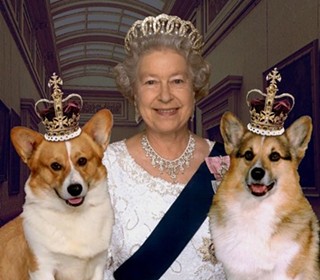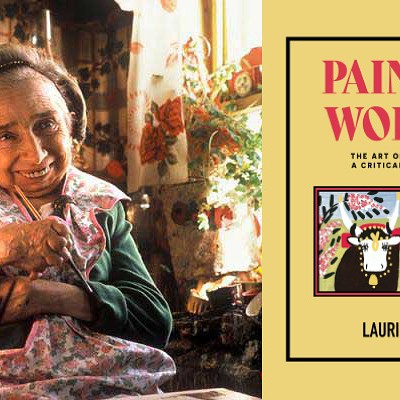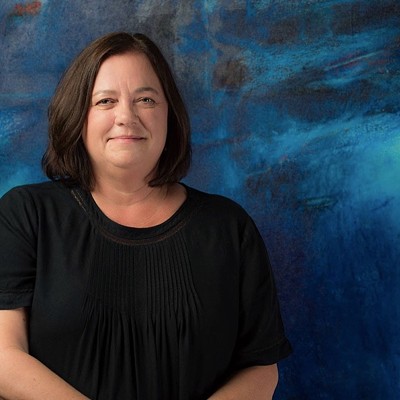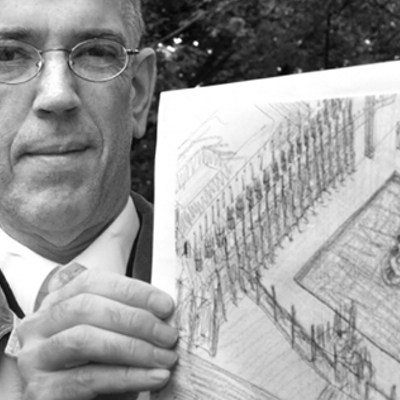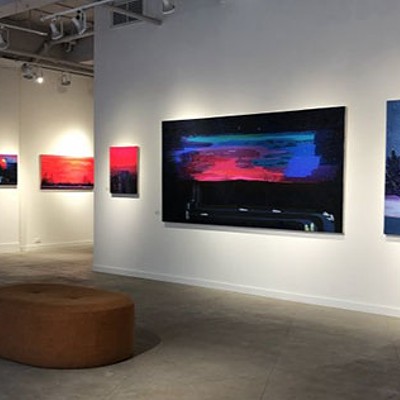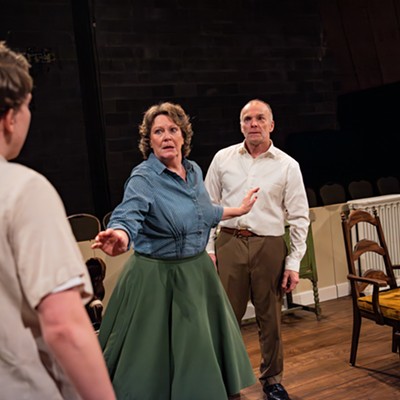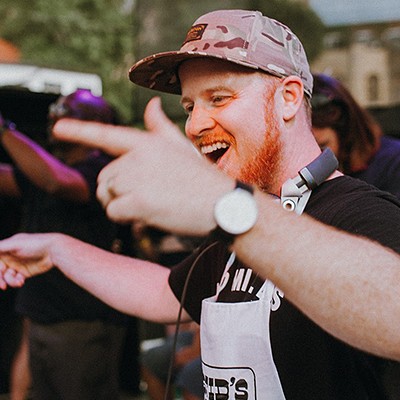The complex personality and tumultuous history of Halifax’s north end have made it an ideal muse for the many filmmakers, artists, poets and authors who live there. This Saturday, during the Go North! event—when north-enders invite the rest of the city to tour over 45 local artist studios, galleries, homes and businesses—two of the scheduled exhibitions give Gottingen Street a loud voice all its own. The timing for The Right Thing to Do: Our Neighbourhood in Words and Pictures, at the Halifax North Memorial Library, couldn’t be better. During the last weekend in August, anti-gentrification graffiti sprayed on central-north houses in the Bauer and Maynard Street area left many residents puzzled and angered, especially because many who live there are lower- to moderate-income renters themselves. Perhaps this tag, found on the side of a Bauer residence, sums up the conflict best: “You can visit anytime but you’re not invited to live here.”
This conflicting sense of ownership is an old, troubling story. Segregation, discrimination, the decline of the local shopping district, transient student populations, fear of street crime, increasing property values and decreasing affordable housing have contributed to the confusion and often, a lack of understanding of the area’s survivalist history. By pulling together iconic archival newspaper clippings, personal stories, photos and drawings from local children, The Right Thing to Do ironically aims to strip away nostalgia by presenting the neighbourhood’s history.
“So let’s start a dialogue. This is what was in the past, this is where we are now and how does this relate to the future?” says Iliah Lorenz-Luca, who developed the exhibition on behalf of her employer and professor, Grant Wanzel, and his non-profit organization, the Creighton/Gerrish Development Association, which has been active for 12 years working toward affordable, mixed-residential housing in the neighbourhood. Entering the final year of her Masters in Architecture, Lorenz-Luca spent a work term with Wanzel, occupied with various design projects and collecting archive materials and interviews for this exhibition. She says, “The nostalgia is really affecting some people—they can’t incorporate the past and the future at the same time. Can you have both?”
In some ways, the exhibition is a pictorial promotion for C/GDA’s projects—they’re set to start development on a new project in the abandoned lot at Creighton and Buddy Daye, and another, a 40-residence two- to three-bedroom condominium, is slated for the next couple of years. Models of projects will be on display with the photos. “The whole idea behind it is—for Grant—it’s really important for the community to know that the company is not doing this in a vacuum,” says Lorenz-Luca. For those who see the photos for the first time, the exhibition is a stunning primer for what has already been lost, thanks to misguided urban development that ignored the needs of a traditionally lower-income residential neighbourhood while focusing attention on the development of the downtown core.
North-enders can mourn the loss of shoe shops, hardware stores and a pastry place, evident in a striking photo of Gottingen and Cornwallis from the 1950s. There’s a stretch of people waiting in front of the Vogue Theatre in 1948, lined up to see a Blondie and Dagwood bumbling adventure. An 1891 article from The Critic commends the “good market and first-class grocery establishment a credit to the street.”
Lorenz-Luca laughs derisively at a 1961 Mail-Star ad announcing the grand opening of a municipal parking lot—still an empty lot at the corner of Gottingen and Maitland—an apparent attempt to return lost business to the area. Juxtaposed against a photo of a house boarded up—many homes were deemed unsafe and torn down to make room for parking lots—there’s little surprise that there’s lingering anger and resentment from longtime north end residents, who have heard the rejuvenation song many, many times before.
Although they had access to some potentially damning historic government documents, especially around the development of Uniacke Square and suggested compensation for those who lost their homes, Lorenz-Luca and Wanzel decided to keep the exhibition pointed, but not negative. “It’s the reality of the area. We don’t want to instill anger in people with this, but some of these photos still do address these issues,” she says. “All of these things happening—how do you relate them? Let’s just put out the images and let people make up their own minds.”
Personally, she sees connections with refugees in other parts of the world, suggesting that in some ways, the north end is a “neighbourhood of displaced people.” The daughter and granddaughter of refugees herself—her grandfather was a political prisoner in Romania—Lorenz-Luca is planning on spending her last year working on a thesis, which will most likely investigate moveable architecture that you could wear or take with you, “If you ever had to leave somewhere right away.”
When artist Helen Verbanz started working on her audio piece Gone Missing, a soundscape of life around Gottingen Street, she decided she wanted to record the carillon of bells at the Fort Needham memorial to the Halifax Explosion. She went to the park several times over a two-week period, but the bells never played. She continued to go back at different times on the advice of different people—every 15 minutes, every half-hour, every hour, once a day to mark the time of the Halifax Explosion—but still, no bells. So Verbanz called the city, which sent an electrician to fix an apparently faulty switch.
“They weren’t aware because they thought someone in the neighbourhood would tell them, but people in the neighbourhood were so used to hearing it, they didn’t notice,” says Verbanz. “It’s ubiquitous to a lot of people, it’s like it’s not there. But when someone else points out they’re not there, people are surprised.”
Gone Missing also refers to another search —like The Right Thing to Do, Verbanz tackles a lack of knowledge about the area’s rich history. “There are aspects I had to look for and search. The piece is a lot about things gone missing or things people don’t know,” she says.
The audio installation will be set up in the “in-between zone” outside of the A. McLaren Gallery, a small window space beside Eyelevel Gallery, and the gallery interior where paintings by Mitchell Wiebe will be on display. Verbanz explains that the exterior speakers’ location and content will “make people react and ask questions, wondering where the sound comes from and prompt some questions about the community.”
Verbanz recorded iconic sounds like the memorial bells and the foghorn, along with sounds of people she met, such as the man who loves to tap dance. A daily visitor to the North Halifax Library, he told Verbanz that whenever he used to meet up with Buddy Daye, the beloved champion boxer and community activist, Daye would join him in a little dance. There are sounds of singing from the churches and people greeting each other. She met another man who coached four generations of baseball teams who discussed how the decline of Gottingen businesses made it difficult to find local sponsors for things like team t-shirts and hats.
While much of her recording will be edited out or used to create a tonal expression or atmosphere that subtly addresses the area’s environment and social conditions, many sounds are still distinct. “People have commented on what it’s like to sit on Gottingen Street on their porch and hear the loud, loud buses go by, so they can’t hear the people next to them because of the sound. That’s something that people notice about their community,” she says.
Verbanz doesn’t live in the neighbourhood, but she’s enthusiastic about what the experience brought her. “I’m so happy I got a chance to know it. I was lucky in meeting these people and that I was able to bear witness to their stories.”
The Right Thing to Do: Our Neighbourhood in Words and Pictures, September 5-9, Halifax North Memorial Library, 2285 Gottingen. Gone Missing, September 9-22, A. McLaren Gallery, 2128 Gottingen.



